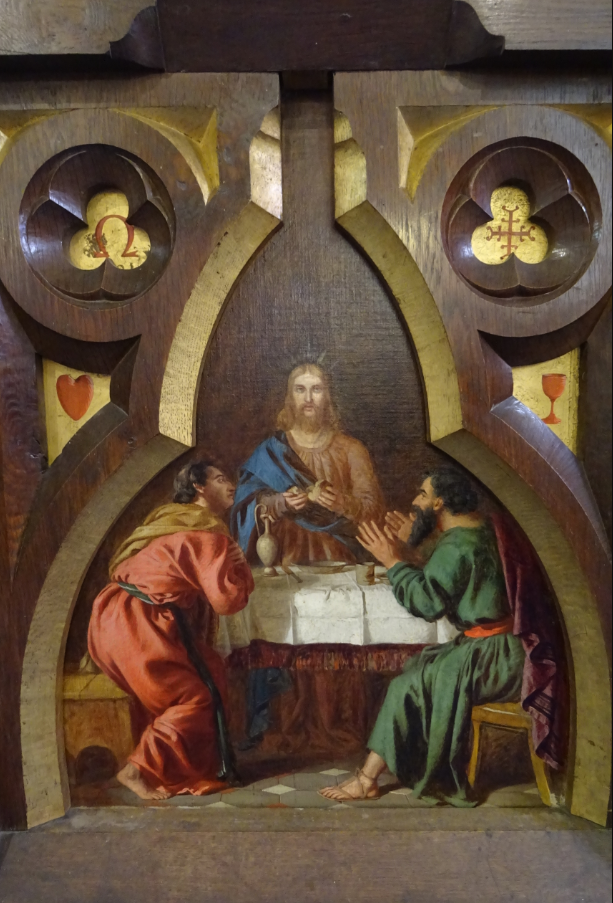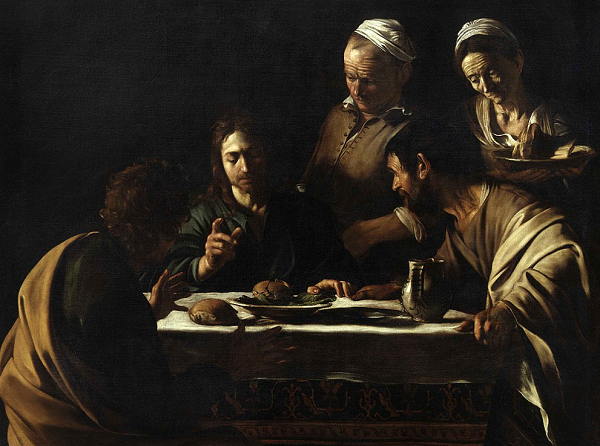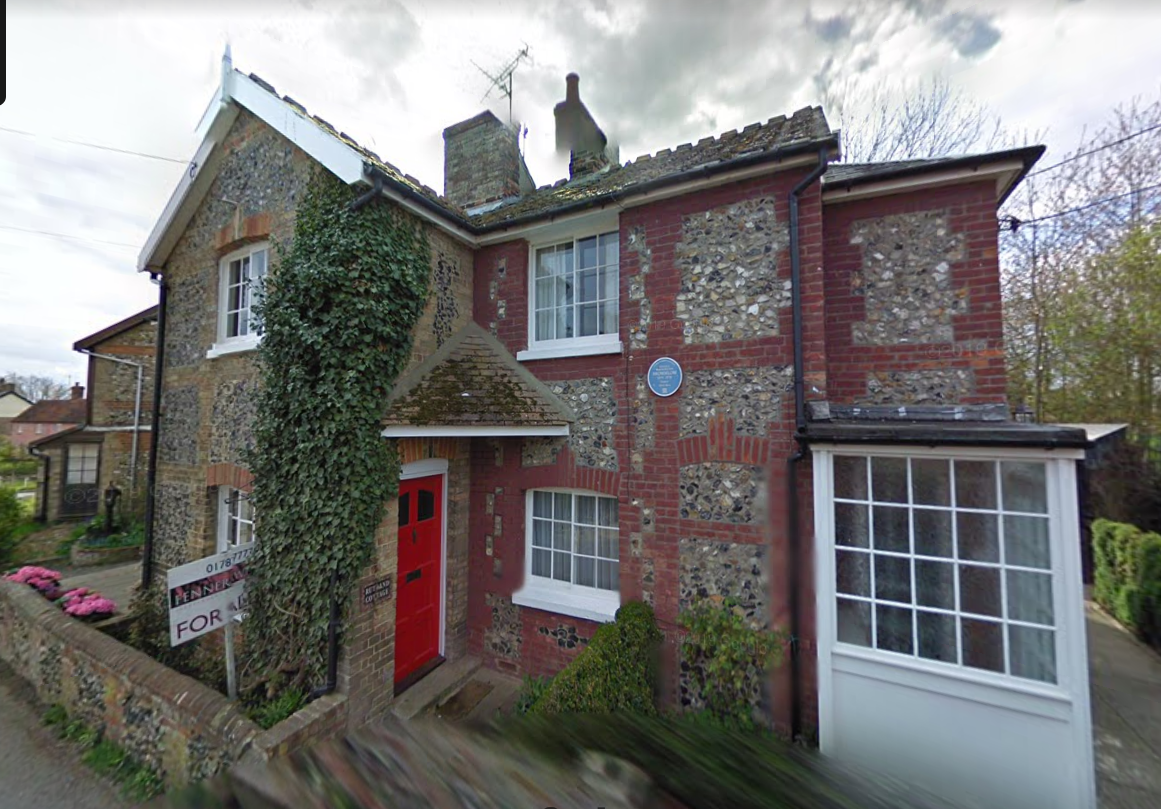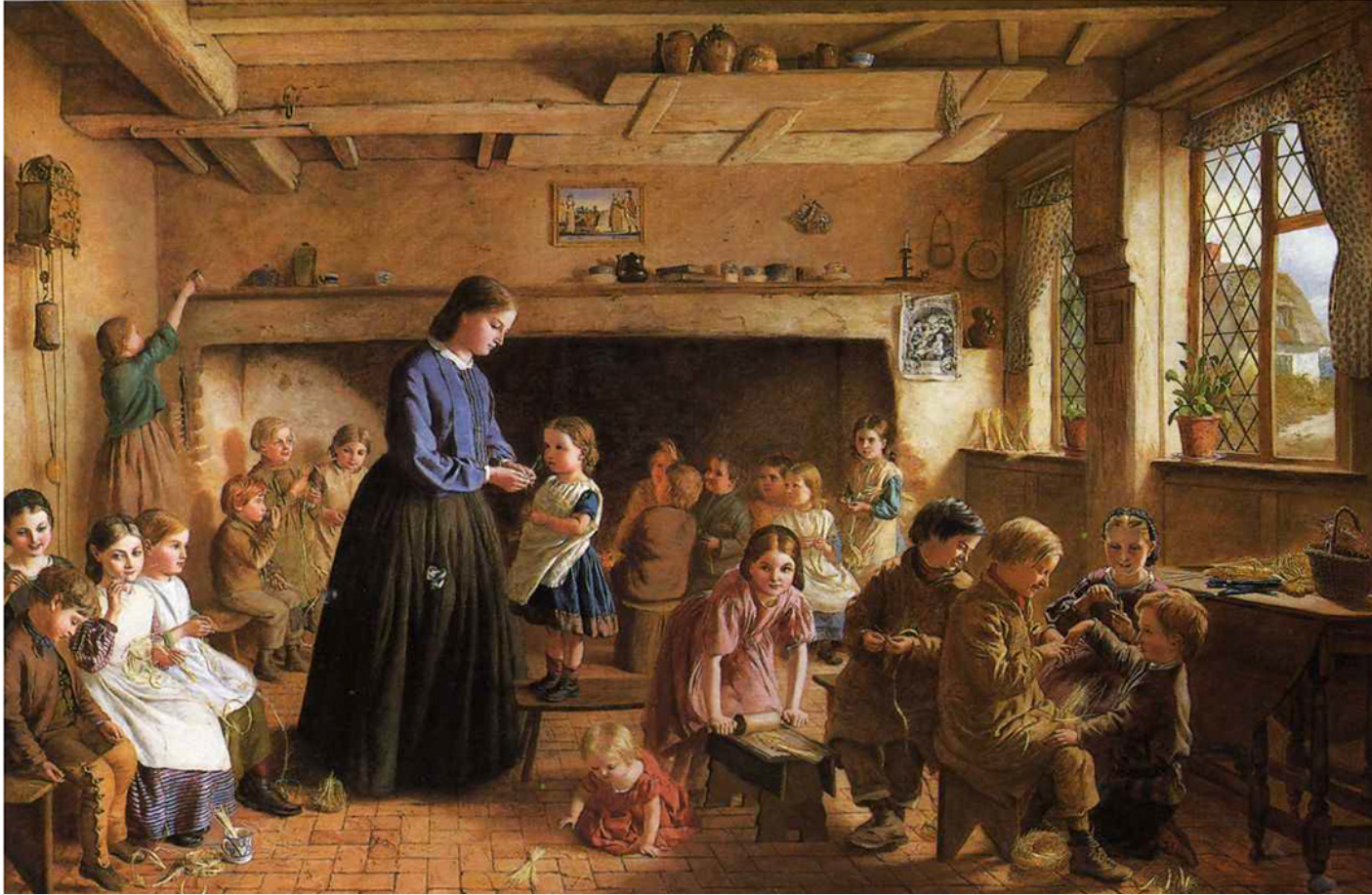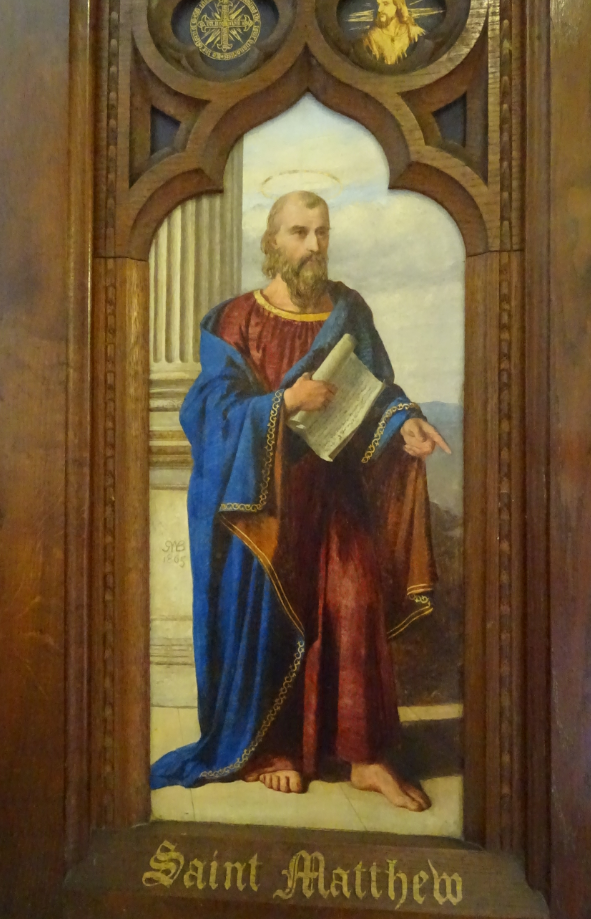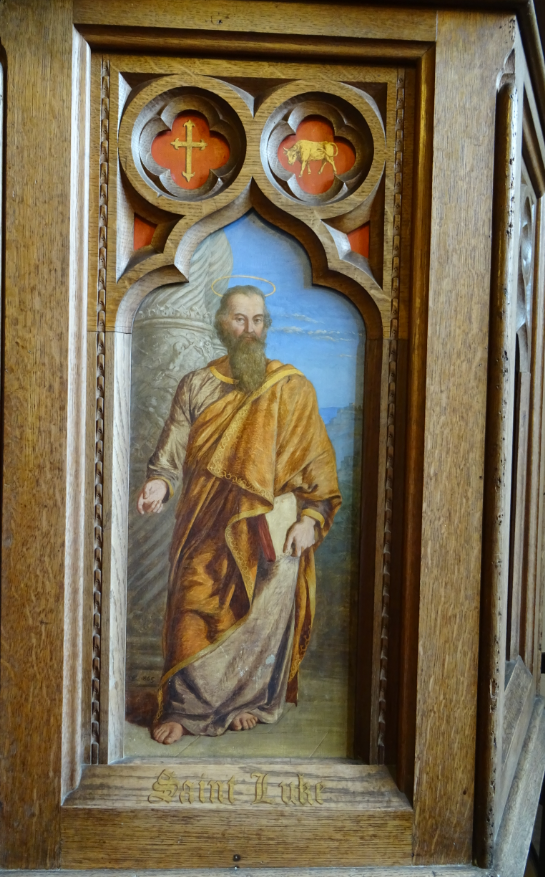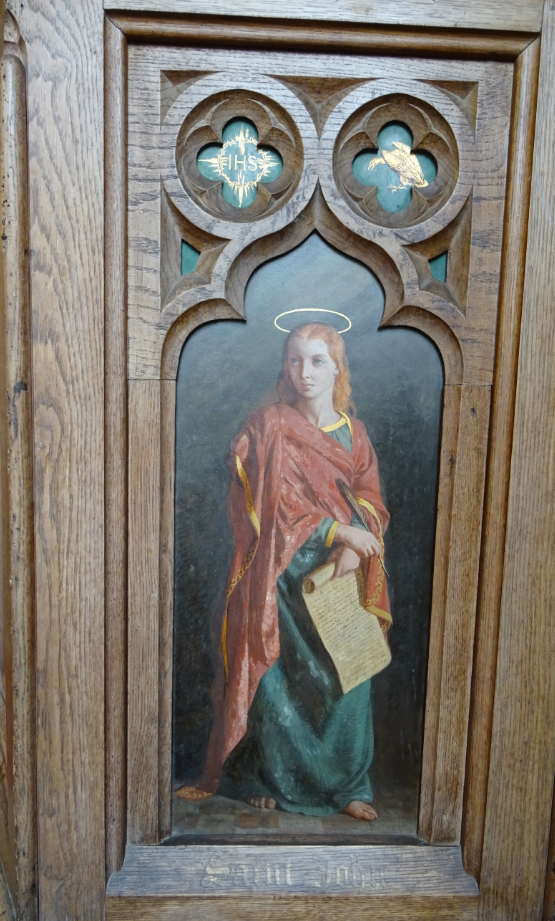George Washington Brownlow
The paintings of George Washington Brownlow that can be seen in the church of St. Mary's are the subject of this page.
I describe those that are on the Pulpit and those that are on the altar.
The background information that I found in the vestry about Brownlow and his Geordie past was shared with Ashley Cooper of Gestingthorpe History Group fame.
A communication with Back to basics: Rethinking rural collections By Oliver Douglas. October 2025 about where the original of Straw Platting.
Cottage sold for and is now let
Fern Lodge, North Road
George Washington Brownlow
George Washington Brownlow is mainly know for his highly romanticised paintings of
rural scenes.
George Washington Brownlow is part of Belchamp Walter's history. He lived and worked in the village
and many of his works
can be seen in St. Mary's Church, Belchamp Walter.
George Washington Brownlow died in 1876 and is buried in
St. Mary's Churchyard.
Top
Why the name George Washington?
The paintings on the Altar
The painting of Abraham sacrificing Issac on the altar of is obviously inspired by the Caravaggio (the painting in the Uffizi).
The Caravaggio:
Supper at Emmaus - another painting on the altar at St. Mary's
Again, another "study" on Caravaggio's version.
There are many paintings on this subject and Caravaggio has more than one.
The Wikipedia page for the Road to Emmaus says:
According to the Gospel of Luke, the road to Emmaus appearance is one of the early post-resurrection appearances of
Jesus after his crucifixion and the discovery of the empty tomb. Both the meeting on the road to Emmaus and the subsequent supper at Emmaus, depicting the meal that Jesus had with two disciples after the encounter on the road, have been popular subjects in art.
Emmaus (Imwas) - Occupied territory West Bank
Canada Park
From Suffolk Artists website:
George Washington Brownlow, was born at Newcastle-upon-Tyne, Northumberland in 1835, third son of Stephen Brownlow
(c1807-10 July 1883), a cordwainer (bootmaker) and his wife Maria (1810-1879), but was not baptised at Bulmer,
Essex until 21 December 1859. In 1841 the family were living at Thompson Street, All Saints, Newcastle, 32 year old
Stephen and 31 year old Maria, with children Stephen 12, James 10, Washington 6 and William 2.
By 1851 they had moved to Wesley Street, All Saints' with the addition of two more children Mary 8 and Robert 2,
they were all born at Newcastle. George received early tuition from William Bell Scott (1811-1890), principal of
the government School of Art in Newcastle-upon-Tyne and then enrolled at Royal Academy schools and by 1860 was
exhibiting widely.
In 1861 George was a 25 year old artist, boarding at 14 Anderson Street, Chelsea, London, the
home of the Hudson family and in 1871 a visitor at Stanley House, King's Road, Chelsea, the home of the Veitch family.
George Washington Brownlow was particularly renowned for his genre paintings with children in oils, but also painted
landscapes and portraits and often painted scenes in Scotland and Ireland. He exhibited at the Royal Academy from
South Parade, Queen's Elm, Brompton in 1860:
The exhibits were:
- 'Last Century's...at Epworth Church, Lincolnshire'
- 'The Mother's Lesson...Wishaw, Lancashire', from 14 Anderson Street, King's Road, Chelsea in 1861
- 'A Claddagh Fisherman's Fireside', from Fern Lodge, Belchamp Walter, Sudbury, Suffolk in 1865
- 'Straw Platting School in Essex', from 15 Great James Street, Bedford Row in 1866
- 'A Findon Fisherman's Fireside', from Fern Lodge, Belchamp Walter, Sudbury, Suffolk in 1869
- 'The First Lesson in Straw Platting', in 1872 'The Last Stile Home' and in 1875
- 'The Sunny Hours of Childhood' also showing at the Royal Scottish Academy 1859 and the Royal Association for the
Promotion of Fine Arts in Scotland and elsewhere.
Note the spelling of Plaiting as in the 1875 painting. The spelling "platting" is used by
Suffolk artists website.
Continuing with the text from Suffolk Artists:
In 1866 the pulpit of Walter Belchamp church in Essex was adorned with the pictures of the four evangelist by Brownlow
and his engravings are included in a series of Fulcher's Ladies' Sudbury Pocket Books.
George Washington Brownlow died at the residence of John Cox Lynch, Esq., surgeon, of 16 Sepulchre Street,
Sudbury,
Suffolk, on 23 July 1876, aged 41, and he was buried in Walter Belchamp churchyard on 26 July 1876.
The following year a memorial window to his memory was placed near to his seat in Belchamp Walter church,
by Samuel Raymond.
At that time (1876) Samuel John St. Clere Raymond's father John Mayne St. Clere was still alive and it is assumed
that JMSR commissioned George to paint for the Church. The memorial window is not dated apart from the date of GWB's death (1876) but if installed by SJSR it would date from 1893.
The stained glass in the Chancel (post 1893) and Tower (1857) are thought to be older and attributed to
William Wailes (1808 - 1881).
This is not consistant with the dedications on the glass itself as Wailes died in 1881.
George's artist brother was Stephen Brownlow (1828-1896), originally a cordwainer, who took evening classes at
Newcastle’s Government School of Art and also became a well-known artist at Newcastle-upon-Tyne.
The 4 Apostles
As seen on the pulpit
Mark
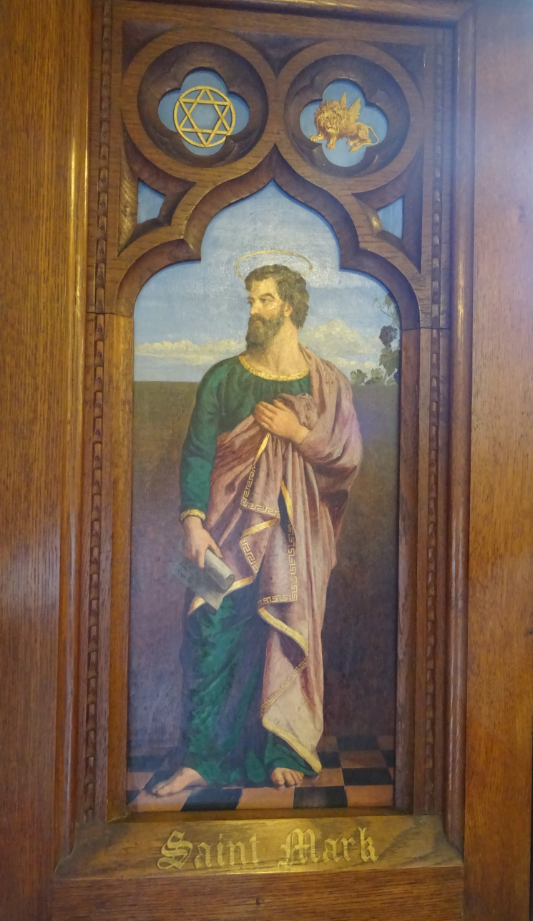
Click an image for more detail.
The Stained Glass in the Chantry arch
This group of windows were inserted into the Chantry arch in memory of George Washington Brownlow by
Samuel John St. Clere.
Why George Washington?
The Christian names George Washington have not been explained.
GWB was one of the school management committee of the New School House,
Belchamp Walter in 1872.
George Washington, the first president of the USA, was a young military man with the
Virginia Company in 1759.
The Wikipedia page for President Washington says;
George Washington (February 22, 1732 – December 14, 1799) was an American military officer, statesman, and Founding
Father who served as the first president of the United States from 1789 to 1797.
Appointed by the Continental Congress as commander
of the Continental Army, Washington led Patriot forces to victory in the American Revolutionary War and served as
president of
the Constitutional Convention of 1787, which created and ratified the Constitution of the United States and the American federal
government. Washington has been called the "Father of his Country" for his manifold leadership in the nation's founding.
The American Washington was alive around 150 years before the George Washington of Belchamp Walter.
There is no indication that there is a connection between the Brownlow family and America.
Blue Plaque
There is a blue plaque on the cottage that George Washington Brownlow lived when he was a resident of
Belchamp Walter.
The plaque is on the wall of Fern Lodge, North Road (at the crossroads), Belchamp Walter. There are incorrect
statements that he lived at Lodge Villa and Rutland Cottage.
ChatGPT and George Washington Brownlow
There are things that ChatGPT doesn't seem to recognize that I feature on this
and other pages on this website.
For example, the fact that he is buried in the Churchyard of St. Mary's Belchamp Walter, that he painted Abraham
sacrificing Issac and Supper at Emmaus on the Altar.
The AI doesn't seem to be aware of the subjects of the paintings on the Altar and it is likely that when this page is indexed it will be picked up for those making queries about George Washington Brownlow.
Sally Woodcock's Treatment Report - 2011
Sally Woodcock was commissioned to inspect and restore the Brownlow paintings on the Pulpit and Altar in 2010/2011.
The author has a copy of her report and it is in the process of being scanned and will be avialable for visitors
to review themselves.
An interesting observation is that the painting on the Alter of Supper at Emmaus is described as The Last Supper.
On consultation with a previous Church Warden, Terry A. Raybould (1994-2012), he did not recollect that there was a discussion on this. The painting was ecribed in the first Church Guide by S. P. Raymond, in 1964, as "The Last Supper" but this was changed to "Supper at Emmaus" by the time the second Church guide was compiled.
Straw Plaiting
George's artistic output as we see in Belchamp Walter is mainly of an ecclesiastical nature.
The page on the Coggeshall Museum's website describes Straw Plaiting. This would appear to have been a true
"cottage industry" of the Belchamp Walter region in the 1850's.
The Artists of Northumbria - Marshall Hall
The following is a transcript of an article from "The Artists of Northumbria" by Marshall Hall (date unknown):
*BROWNLOW, George Washington (1835-1876) Genre, portrait, landscape and religious painter in oil; modeller. He was born at NEWCASTLE the son of a cordwainer, and received his first tuition in art at the Government School of Design in the town under William Bell Scott (q.v.). At the age of twenty he was awarded a gold medal for his work as a student, and as a result of this achievement came to the notice of his future principal patron, the Rev. J. St. Clere Raymond, of Belchamp Hall, Belchamp Walter, in Essex. The first portrait painted by Brownlow was of Raymond, and when his patron some time later succeeded to the Belchamp estate he induced his protégé to settle in a cottage at Belchamp Walter. Brownlow meanwhile had enrolled as a student at the Royal Academy Schools, and made such good progress that by 1858 he was exhibiting at both the British Institution and the Suffolk Street Gallery. By 1860 he had commenced exhibiting at the Royal Academy, remaining a regular exhibitor
Sadly the scan of the article seems to be incomplete. However, it does feature a print of the painting "A Fisherman's Cottage, Ireland". A note says that the painting sold for £1,200 in March 1984.
HISTORY OF NEWCASTLE-ON-TYNE - NewCastle Library BY R.K. CHARLTON 1935.
Another article found with the article above was one from HISTORY OF NEWCASTLE-ON-TYNE.
Another notable name in our list of deceased painters is George Washington Brownlow, who was born in Newcastle, but passed a great part of his life in the pursuit of his art in Scotland and Ireland, and his latter years in the south of England. He was a regular exhibitor in the rooms of the Royal Academy, and his works are beautiful examples of delicate finish and of refined and truthful colour. They are principally cottage interiors, though his landscapes are rare examples of conscientious study and grasp of nature in her more peaceful moods, and his portraits are perfect works of art. Good as his accomplished work is, we doubtless would have had from him some greater and more widely known display of his skill, had he not unhappily been cut off in the prime of his life and in the full and matured exercise of his powers,
He died at Sudbury, Suffolk, in 1876, and a stained glass window has been erected to his memory in the church there by one of his friends and patrons. Its execution was most appropriately
entrusted to his fellow-townsman and brother artist, the late Mr. Wailes
Again, this confirms the local connection and George Washington's heritage. It also makes the connection between him and his "fellow-townsman" William Wailes who was given the commission to design and manufacture of the stained glass windows found in the chantry arch in St. Mary's Church.
William Wailes has been attributed as the artist responsible for the majority of the stained glass in St. Mary's.
Article from 1858 Suffolk Free Press newspaper archive
November 24th 1859
Fire on Sunday last on the premises of Robert Collar, grocer and straw plait dealer of Gt Yeldham, extensive damage
was done, it is supposed to be from a spark from a candle, we regret to say quantities of straw plait were destroyed,
there was damaged to £40 of uninsured goods although the premises were insured.


.jpg)
